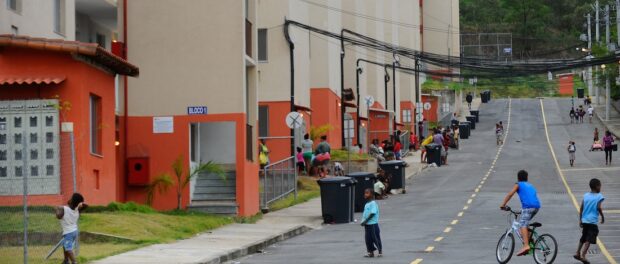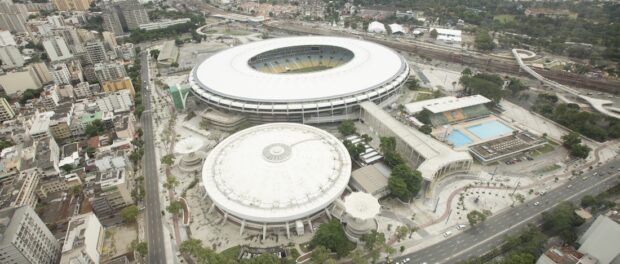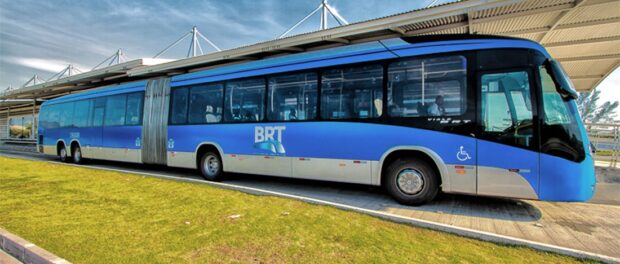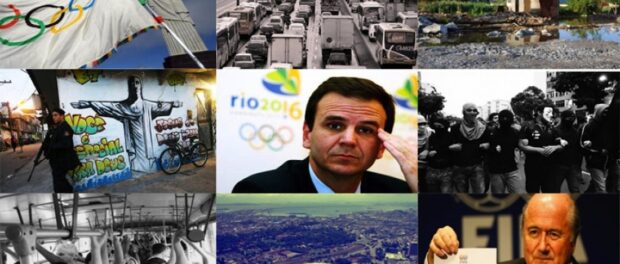
The ongoing urban transformations in Rio de Janeiro continue to garner international academic attention, and are the basis for the e-book publication of The Metropolis of Rio de Janeiro: A Space in Transition in English last year. The book [download here] is a collection of seventeen articles, the authors of which are professors at the Federal University of Rio de Janeiro, as well as postdoctoral and postgraduate students at the university’s Institute of Research and Urban and Regional Planning (IPPUR). The book was compiled and edited by Luiz Cesar de Queiroz Ribeiro, a professor at IPPUR and the coordinator of the National Institute of Science and Technology’s Metropolises Observatory.
The Metropolises Observatory emerged in the 1990s, analyzing the transformations of the needs and social inequalities in the Metropolitan Region of Rio de Janeiro. It now focuses its efforts on international dissemination of the Brazilian metropolitan reality within the context of the mega sporting events. The collection of articles in The Metropolis of Rio de Janeiro: A Space in Transition presents to foreign audiences the central issues related to the current commodification of the city, while focusing particularly on the mega-events’ impacts on Rio’s present and future state.
The book is divided in three parts: Inequalities and Territory; The Impacts of Mega-Events on Urban Dynamics; and Politics and Government. Though a wide range of Brazilian and Rio-specific urban processes are brought to attention in this collection, the language is geared more towards an academic audience than an individual attempting to learn of the impacts of the mega-events on the city. Many of the articles are statistic-heavy and offer significant quantitative information; others are qualitative in nature and easier to grasp. Nevertheless, the authors clearly lay out their arguments clearly and leave room for other researchers to elaborate on unanswered questions, allowing for further contributions to the debates on the transformative processes taking place. I would recommend it to those wishing to gain an in-depth analysis of politics and citizenship, transportation, segregation, the social question, and of course, mega-events.
1. The favela in the city-commodity: deconstruction of a social question
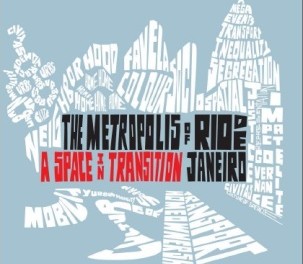 Authors Luiz Cesar de Queiroz Ribeiro and Marianna Olinger argue that the present debate surrounding the favelas’ existence in Brazilian social space comes from its continuous valuation as a market asset. If it is well connected to the city, it is then turned into a commodity. This is exemplified by the cycle of urban regeneration currently taking place, as well as Rio’s responsibility as host city which now sees the coexistence of favela removals and integrative solutions. The limits of the already-developed markets, which are constantly expanding, establish the favela as an unprecedented space for exploration where there exists disputed control over what may be destroyed or urbanized in this new city form.
Authors Luiz Cesar de Queiroz Ribeiro and Marianna Olinger argue that the present debate surrounding the favelas’ existence in Brazilian social space comes from its continuous valuation as a market asset. If it is well connected to the city, it is then turned into a commodity. This is exemplified by the cycle of urban regeneration currently taking place, as well as Rio’s responsibility as host city which now sees the coexistence of favela removals and integrative solutions. The limits of the already-developed markets, which are constantly expanding, establish the favela as an unprecedented space for exploration where there exists disputed control over what may be destroyed or urbanized in this new city form.
2. The favela/(formal) neighborhood contrast in the social space of Rio de Janeiro
Currently, there is a revival of the portrayal of favelas as part of another social and cultural world. Here, authors Luciana Corrêa do Lago and Luiz Cesar de Queiroz Ribeiro submit this (di)vision of Rio de Janeiro to critical reflection by examining the evolution of favela residents during an almost sixty year period, analyzing the key social and demographic traits of those living in favelas and city districts, and assessing the social distance between favela and formal city dwellers based on income. The authors find that the favela/non-favela division to be the spatial expression of the inequality that is ever present in Brazilian society, because favelas are home to a concentration of those who have the biggest disadvantages in accessing opportunities: the youngest, the non-whites, and those with poor schooling. The text compares this division to ghettoization in American cities, pointing to similarities between the stigmatization of the territories, the limited presence of the State, and the inhabitants’ lack of control over their social representation.
3. Work and housing in the periphery of a large metropolis: for an economically-oriented urban policy
In this article, Luciana Corrêa do Lage examines the quantity, quality and spatiality of precarious work in relation to the quality of life in the city, considering that places and distances express power relations in this class-based society. The author uses a structural, statistical analysis in order to explore the meaning of precarious or informal work in the context of changes in labor relations over the past three decades. The author insists that urban policies need to incorporate the dimension of daily journeys in order to promote the social welfare of citizens and break free of the socio-spatial barriers that segment Rio de Janeiro.
4. The social imaginary of home ownership and its effects: reflections about real estate in Brazil
Authors Adauto Lucio Cardoso, Flávia de Sousa Araújo and Samuel Thomas Jaenisch question the meaning of property ownership in the current context of urban Brazil. The “dream of home ownership” resides in the desire to overcome living conditions seen as unsatisfactory, to access a more complete experience of citizenship and to permanently inhabit the urban fabric. The authors hypothesize that the Minha Casa Minha Vida (MCMV) federal housing program further underlines the importance of this dream. For them, MCMV is a concept based on ideas of equality and individual capacity. Yet they question whether this policy has the potential to effectively diminish existing inequalities in Brazilian cities, or whether it reinforces certain processes of social division.
5. The colors of the urban borders: residential segregation and ‘racial’ inequalities in the metropolitan region of Rio de Janeiro
In this article, authors Luiz Cesar de Queiroz Ribeiro and Filipe Souza Corrêa investigate race and whether a black or brown individual holds an unequal social status in terms of opportunities and access to social welfare regardless of his position in the social division of the city territory, or whether residential segregation distributes opportunities and urban social welfare unevenly among groups of color. They conclude that the city’s socio-spatial hierarchy is more a result of the territorial concentration of whites who have greater social status, prestige, and economic power, rather than a compulsory removal of blacks from that space.
6. Territory and employment: urban segregation, urban segmentation and occupational opportunities in the Metropolitan Region of Rio de Janeiro
Authors Luiz Cesar de Queiroz Ribeiro, Juciano Martins Rodrigues and Filipe Souza Corrêa analyze the relationships between the social division of the metropolitan territory and the conditions governing access to opportunities in the labor market. They examine the phenomenon of territorial segmentation (the distance between place of residence and place of employment) and spatial mismatch (the concentration of jobs in central areas remain far from peripheral residential growth). The article demonstrates that the social organization of urban space is both a reflection of the structure of macro social inequalities and of manipulated relationships between trends of segmentation of the labour market, residential segregation and territorial segmentation.
7. Resident perceptions of urbanization and elite encroachment in a Jacarepaguá favela
The construction of the 2016 Olympic Park and the exhaustion of space preventing further development in Barra da Tijuca has driven Barra-style growth into Jacarepaguá. Consequently, the favela of Asa Branca has experienced increased market activity and state presence. Author Matthew Richmond strives to discover how its residents view the processes that offer new opportunities for income and employment, and which also destabilize long-established patterns of community relations. Since favela residents place a significant value on community, the emerging build-to-rent market has created conflict due to the outsiders’ lack of commitment to the neighborhood. Furthermore, many favela residents believe they would be perceived negatively, particularly as a result of discrimination in media representations.
8. Urban frontiers and educational opportunities: the case of Rio de Janeiro
Mariane C. Koslinski and Luiz Cesar de Queiroz Ribeiro’s article reflects on the territorial segmentation and residential segregation in the reproduction of educational inequalities within Rio de Janeiro. The article investigates the models of collective socialization (patterns of behavior that are shaped by frequent interactions and familiar contacts) and institutional socialization (patterns of behavior that are shaped by the quality, quantity, and diversity of the services provided in their neighborhoods), arguing that public schools are organized as institutions that are discriminating and discriminatory. The authors propose that when neighborhood boundaries are fixed and clear, a ‘neighborhood-effect mechanism’ impacts educational opportunities.
9. Residential segregation school quasi-market and school segmentation in the context of Rio de Janeiro
This article aims to understand how residential segregation and the functioning of a ‘hidden quasi-market’ can impact educational stratification. The quasi-market grants opportunities of choice to the students who are seeking schools based on the quality and type of education they provide. The authors Mariane C. Koslinski, Marcio da Costa, Fátima Alves, and Luiz Cesar de Queiroz Ribeiro map student flow patterns in order to identify the factors that condition the chances of being enrolled in municipal public schools.
10. Mega sporting events in Brazil: transformation and commodification of cities
This article discusses economic and political transformations that exploit the city as an object and field of business, aiming to create stimulating, innovative and safe places to live and visit. Authors Luiz Cesar de Queiroz Ribeiro and Orlando Alves dos Santos Junior introduce the city management form of ‘urban entrepreneurship.’ This involves an inter-urban competition between cities that each attempt to gain and retain benefits through management practices that attract capital. Thus, World Cup host cities experience major urban restructuring as they try to create conditions of production, circulation and consumption. The impacts of mega-events based on this emerging pattern of urban entrepreneurial governance needs further analysis, particularly when considering the gravity of the protests that took place during the 2014 World Cup and the increased level of violence in favelas around Rio de Janeiro.
11. The right to housing, the 2014 World Cup and the 2016 Olympics: reflections on the case of Rio de Janeiro, Brazil
The twelve selected host cities of the recent World Cup were encouraged to use this opportunity to expand their investments. Studies associate the mega-events, both directly and indirectly, with the expulsion of lower-income people from valued areas. Authors Orlando Santos Junior and Mauro Santos discuss questions related to the urban policies employed by public authorities and the justification of removals on the basis of event preparation. They found that the right to housing can be both denied and promoted, provided it allows and does not interfere with the process of commodification of the city.
12. Urban mobility in the “Olympic City”: a transportation revolution in Rio de Janeiro?
Urban mobility in Brazil is typically considered through the lens of engineering and technical urbanism, while its social impacts are minimized in discourse. The current ‘urban mobility crisis’ exists because of the widespread preference for individual vehicles rather than the use of collective mass transit modes. Moreover, the latter has a weak physical integration and unequal distribution in the city of Rio de Janeiro. The author, Juciano Rodrigues, critiques this reality in Rio by analyzing the impact of investments on urban dynamics and the socio-spatial configuration of the city, and questions whether Rio could experience a revolution in urban mobility systems. Currently, the author remarks that no integrative plan exists to consider Rio de Janeiro a “metropolitan city” due to the territorial concentration of transportation interventions and the insistence on the highway system model.
13. From culture to spectacle, the new logics of Brazilian football
At the time of this article was written, construction was still underway on twelve major stadiums for the 2014 World Cup, with a reputed price tag of R$6.9 billion, 97% from public coffers. After cost overruns, the government stated they “were not paying for the World Cup, but investing in Brazilian cities.” Author Christopher Gaffney gives a history of the development of futebol in Brazilian culture, touching upon corrupt regulations, sports management, and aspects of violence. He dissects the changing role of stadiums within the urban environment under different political and economic institutions, and remarks that the current trajectory of spectator rights has the potential to permanently alter an essential element of Brazilian cultural identity.
14. Changes and continuities on Brazilian urban governance: the impacts of the sporting mega-events
Author Erick Omena de Melo addresses the contradictory convergence of two tendencies of Brazilian urban governments: the institutionalized participation of civil society towards the construction of public policy and the dominant growth of urban entrepreneurship involving anti-democratic practices. The economic evolution of the mega-events has amplified the social costs for host countries. Popular participation and transparency in the planning of these events have been identified as central points to offset the enormous power inequalities between international corporations and many of the host cities’ inhabitants. However, the proceedings and potential instances of participation that are integrated into the Brazilian institutional legal apparatus are not part of the new agencies that were created to deal with the urban projects connected to the World Cup and Olympics.
15. From discourse to reality: impacts of Rio’s “transportation revolution” on socio-spatial justice
There exists a contradiction between Rio’s urban marketing of short-term investments for mega-events’ needs and the city’s long-term urban planning challenges. Author Jean Legroux attempts to evaluate the impacts of Rio’s main transportation projects underway. The BRT system emerged as the dominant solution for meeting the city’s transportation needs for hosting mega-events, and for being the least expensive option for solving its mobility crisis. However, this research demonstrates the unequal social and territorial distribution of the revolution’s benefits. The analysis of the transportation projects reveals the reinforcement of segregation because the investments are prioritized along the four “natural urban centralities,” while elsewhere, the road model persists.
16. Political culture, citizenship and the representation of the urbs without citivas: the metropolis of Rio de Janeiro
Authors Luiz Cesar de Queiroz Ribeiro and Filipe Souza Corrêa explore the mechanisms involved in the political disparities between metropolitan citizens. The logic of distrust guides the political behaviour of Brazilians and also blocks the development of active citizenship. The Rio de Janeiro Metropolitan Area is organized in a system that fragments the different portions of society across the physical space of the metropolis. This segregating and exclusionary logic results in the marginalization of a large portion of the metropolitan population with regard to their rights as citizens.
17. Local democracy and metropolitan governance: the use of Rio de Janeiro
According to authors Luiz Cesar de Queiroz Ribeiro and Ana Lucia Britto, to overcome politically weakened territories, large cities need institutions capable of involving economic, political and social actors in legitimate collective actions addressing the development of these major cities and their contemporary issues. Large cities are governed by the non-coordinated action between three levels of government and by the free play of private interests that are fragmented and in competition with each other. With this context in mind, the authors determine how the institutional fragmentation in Rio results from historical, sociological and geo-economic conditions as well as factors related to the local government in Brazil.
Caitlin Dixon holds a Bachelor’s Degree in Geography: Urban Systems from McGill University, and has a keen interest in exploring the creation and use of public spaces in different urban landscapes.

